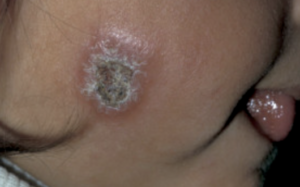Cutaneous Leishmaniasis
Leishmaniasis is a parasitic disease transmitted by the bite of infected female sandflies. It is caused by more than 20 species of Leishmania which is a flagellated protozoa.
Epidemiology:
– Worldwide, there are approximately 2 million new cases of leishmaniasis annually.
– Cutaneous or mucocutaneous disease presents 75% of the affected individuals
– Over 90% of cutaneous infections with Leishmania occur in the Middle East (Afghanistan, Algeria, Iran, Iraq, Saudi Arabia, Syria) and South America (Brazil, Peru, Colombia)
The incubation period of Cutaneous leishmaniasis is usually several weeks to 2 months. The clinical manifestations of leishmaniasis depend on the species of Leishmania, the host’s cell-mediated response, and the ability of the parasite to evade host defense mechanisms. Cutaneous leishmaniasis is divided into two subsets: Old World and New World. Old World cutaneous leishmaniasis caused by L. major or L tropica, and less often L.infantum (Europe) or L. aethiopica (Ethiopia and Kenya). In the New World, cutaneous leishmaniasis is caused primarily by L. mexicana and the L. braziliensis complex. Both Old World and New World cutaneous leishmaniasis usually begin as a small, well-circumscribed papule at the inoculation site (usually involve the exposed sites of the skin—arms, face, legs). This lesion may slowly enlarge over several weeks into a nodule or plaque and then become ulcerated.
Treatment:
· For an isolated lesion, conservative therapy (e.g. observation, heat, cryotherapy) or topical paromycin can be used
· For more extensive disease, IV or IM pentavalent antimony (sodium stibogluconate, meglumine antimonate) or oral miltefosine
Written by: Dr. Arwa Alsubhi, dermatology resident.
References:
-Bolognia textbook of dermatology
-Dermatology Essentials


